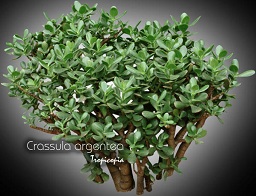Table of contents
Jade Plant

Latin Name: Crassula argentea
Category: Cactus & Succulent
Family: Crasssulaceae
Origin: South Africa
Climate: Subtropical arid
Growing Zones: 11, 8
Care Instructions
The Jade Plant (Crassula argentea) is a subtropical arid plant that originates from South Africa. This cactus & succulent plant belongs to the Crasssulaceae family and is well-suited for growing in USDA zones 11, 8.
Complete Care Guide for Jade Plant (Crassula argentea)
Watering Requirements
The Jade Plant, or Crassula argentea, is a succulent that thrives on a careful watering regimen. It is essential to allow the soil to dry out completely between waterings, as overwatering can lead to root rot. During the growing season, which typically spans from spring to early fall, water the plant every 2-3 weeks. In the winter months, when the plant enters dormancy, reduce watering to once a month or even less, depending on the humidity levels in your home. Always check the soil moisture by inserting your finger about an inch deep; if it feels dry, it’s time to water. When you do water, ensure that you water thoroughly until it drains out of the bottom of the pot, but never let the plant sit in standing water.
Light Conditions
Jade Plants prefer bright, indirect sunlight but can also tolerate direct sunlight for a few hours each day. Ideally, place your plant near a south or west-facing window where it can receive ample light. Insufficient light can lead to leggy growth and a lack of vibrant color, while too much direct sunlight can scorch the leaves. If you notice the leaves turning red or brown, it may be a sign of sunburn. For optimal growth, rotate the plant every few weeks to ensure even light exposure on all sides.
Soil Preferences
The ideal soil for a Jade Plant is well-draining, allowing excess moisture to escape quickly. A commercial cactus or succulent mix works well, or you can create your own by mixing regular potting soil with sand or perlite in a 2:1 ratio. This will enhance drainage and prevent water retention, which is crucial for the health of the plant. Fertilization is not necessary for Jade Plants, but if you choose to fertilize, do so sparingly during the growing season with a diluted, balanced fertilizer every 4-6 weeks. Avoid fertilizing in the winter months when the plant is dormant.
Pests and Diseases
While Jade Plants are relatively resilient, they can be susceptible to pests such as mealybugs, aphids, and spider mites. Regularly inspect the leaves and stems for any signs of infestation. Mealybugs appear as small, white cotton-like clusters, while spider mites may cause fine webbing on the plant. If you notice any pests, treat the plant with insecticidal soap or neem oil, ensuring to cover all surfaces of the plant. Additionally, Jade Plants can suffer from diseases like root rot, which is often caused by overwatering. To prevent this, ensure proper drainage and avoid letting the plant sit in water.
Special Care Tips
To keep your Jade Plant healthy and thriving, consider the following special care tips: First, avoid sudden temperature changes; Jade Plants prefer temperatures between 65°F and 75°F (18°C to 24°C) and should be protected from frost. Second, dust the leaves regularly with a damp cloth to keep them clean and allow for optimal photosynthesis. Third, if your Jade Plant becomes too leggy, you can prune it back to encourage bushier growth. Finally, consider repotting your Jade Plant every 2-3 years to refresh the soil and provide more space for growth. With these care tips, your Jade Plant will not only survive but flourish, becoming a beautiful addition to your home or garden.








